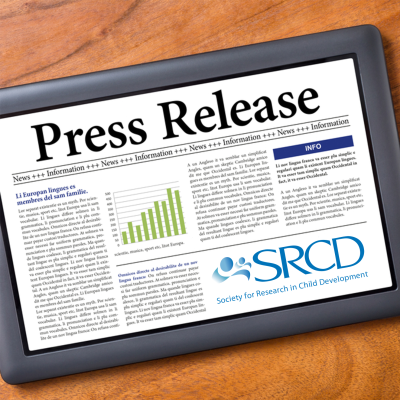Modeling Prosocial Behavior Increases Helping in 16-Month-Olds
PRESS RELEASE / CHILD DEVELOPMENT: Embargoed for Release on April 17, 2019
Shortly after they turn 1, most babies begin to help others, whether by handing their mother an object out of her reach or giving a sibling a toy that has fallen. Researchers have long studied how this helping behavior develops, but why it develops has been examined less. A new study looked at the role of imitation to find that when 16-month-olds observe others’ helping behavior, they’re more likely to be helpful themselves.
The findings come from researchers at the University of Münster and Free University Berlin in Germany. They appear in Child Development, a journal of the Society for Research in Child Development.
“Our study is the first to demonstrate that observing helping, or prosocial, behavior in others affects infants’ prosocial behavior and provides a critical mechanism in early prosocial development,” says Joscha Kärtner, professor of developmental psychology at the University of Münster and senior author of the study.
In two experiments, the researchers investigated babies imitating helping behavior. The study looked at 91 infants (16-month-olds) from Western middle-class families living in a midsized city in Germany.
In the first study, the babies repeatedly observed an adult helping or not helping another person who showed that she needed an object. For example, an experimenter needed three cups to build a tower, but she could not reach the cups. Babies were given the opportunity to help her when she reached for the cups. Nearly half of the children helped when they had seen an adult helping her, whereas only a few children helped after having observed an adult not helping her.
The second study sought to determine whether infants simply imitated behavior they had seen or whether they were more selective and considered the neediness of the person who wanted the object. In the second study, the same experiments were done, but in one of the conditions, the adult didn’t need the object. For example, an experimenter building a tower reached for objects that were close by rather than those that were far away, suggesting that she didn’t need the items that were far away. Once again, children who had seen an adult helping the experimenter were more likely to help when given the opportunity, but when the adult didn’t need the object, children were somewhat less inclined to imitate the adult who helped.
“These findings tell us that children’s prosocial development may be affected not only by direct and active structuring of helping situations by others, as when parents offer suggestions to babies to help someone, but also through learning by observing people who help others,” according to Nils Schuhmacher, a postdoctoral researcher at the University of Münster, who led the research. “The study highlights the importance of having prosocial role models.” These include individuals who explain to infants when they are engaged in helping behavior and who give infants the opportunity to observe helping behaviors in others, such as when siblings help each other during play or a parent comforts a child who has been hurt.
###
Summarized from Child Development, Modeling Prosocial Behavior Increases Helping in 16-MonthOlds by Schuhmacher, N (University of Münster), Köster, M (University of Münster, Free University Berlin), & Kärtner, J (University of Münster). Copyright 2018 The Society for Research in Child Development, Inc. All rights reserved.


